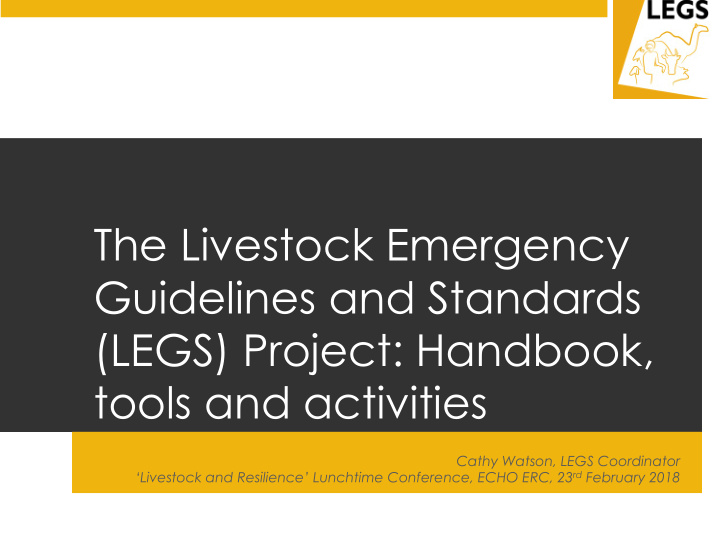



The Livestock Emergency Guidelines and Standards (LEGS) Project: Handbook, tools and activities Cathy Watson, LEGS Coordinator ‘Livestock and Resilience’ Lunchtime Conference, ECHO ERC, 23 rd February 2018
Rationale for LEGS § Cycles of inappropriate and badly implemented livestock relief projects: Poor analysis § Local capacities and services overlooked or undermined § Urgency and timing often the excuse but … § Assistance often late, even in slow-onset droughts § § Limited impact assessment § Weak coordination between development and emergency
What is LEGS? § International standards § Improving the quality of livestock programmes § Designed for humanitarian context § Draws on experience and process of Sphere Project (companion standard) § Process to design and implement projects
The Aim of LEGS To support the 1 Assist in the identification of most saving of lives appropriate livestock- and the saving related technical interventions in of livelihoods emergencies through two 2 Provide standards, actions and guidance key strategies: notes for these interventions based on good practice
LEGS Handbook Chapter 4: Destocking Introduction to LEGS and General principles, decision-making and how to use this book Chapter 5: Veterinary support Specific LEGS interventions Chapter 1: Livestock, livelihoods and Chapter 6: Feed supplies emergencies planning Chapter 7: Provision of Chapter 2: Core water Standards common to all livestock interventions Chapter 8: Livestock shelter and settlement Chapter 3: Initial assessment and Chapter 9: Provision of identifying responses livestock The Core Standards and Technical Chapters all include: Minimum Standards, Key Actions and Guidance Notes
The LEGS Approach Stage 3 Stage 4 Stage 1 Stage 2 Analysis of Monitoring Technical Initial Response and Interventions Assessment Identification Evaluation & Options Tools for the LEGS Approach
Initial Assessment Checklists 1. Role of livestock in the livelihoods of the affected community 2. Nature and impact of the emergency 3. Possible actions given the local context, capacities, and systems Plus: Checklists and indicators for each technical chapter
The LEGS Participatory Response Identification Matrix (PRIM) Photo credit: Astrid de Valon
Using the PRIM Set the phases of the emergency – these differ Consider the three LEGS for slow-onset, rapid-onset objectives against each of the and complex emergencies technical options Livelihoods objectives Emergency phases Technical options Immediate Protec t Rebuild Benefits assets assets Destocking - - - Vet support ***** *** *** Feed *** Water Shelter **** Provision of **** livestock With stakeholders, add scores to With stakeholders, add arrows show how much the technical to the relevance of the technical option could impact on each LEGS option across the different objective phases of the emergency
Completed PRIM: example of Slow Onset emergency - drought in Africa Technical Livelihoods Objectives Emergency Phases interventions Immediate Protect Rebuild Alert Alarm Emergency Recovery assistance assets assets Destocking ***** *** ** Vet Support * ***** **** Feed * *** **** Water * *** **** Shelter n/a n/a n/a Provision of n/a n/a ***** livestock Scoring against LEGS objectives: Emergency Phases: ***** very positive impact on objective à appropriate timing for the intervention **** good impact on objective *** some impact on objective ** small impact on objective * very little impact on objective n/a not appropriate
LEGS Decision Trees
LEGS Project current activities § LEGS secretariat : website, mailings, communications and awareness raising § Evaluation and impact assessment using LEGS tools and indicators § Publications and research: additional translations and briefing papers § Dissemination of LEGS Handbook 2 nd Edition § LEGS Training programme …
LEGS Training Programme 26 TOTs: 500 For: LEGS LEGS Trainers Trainers in 80+ countries For: 280+ in 50+ practitioners countries For: managers of 1 practitioners For: decision- makers and 15+ donors Gender: in For: practitioners preparation
Humanitarian Standards Partnership
LEGS Uptake Key reference in different regions: § International organisations: FAO, UN-OCHA, OFDA, ECHO, DFID, ICRC, World Bank § NGOs: CARE, CAFOD, Trócaire, World Animal Protection, VSFs… § National governments: e.g. Ethiopia; Kenya; India; Indonesia; Vietnam
Importance of timely and appropriate livestock-based responses: § Contribute to prevention and preparedness § Protect and rebuild livelihood assets § Support recovery and livelihoods resilience § Can be cost-effective: § For every $1 spent on destocking in Ethiopia, $311 saved in aid and animal losses § Can improve nutritional resilience and reduce dependence on food aid…
Example: Supplementary livestock feeding in Ethiopia § Selected milking animals, close to women and children § Objectives: maintain milk supply; increase milk consumption by children; prevent malnutrition Results: § Milk production increased 200- 1000% § Child access to milk from 25% to 79% for cattle and 41% to 89% for sheep/goats
Lessons and Challenges • Mainstreaming LEGS-based good practice consistently • Implementation of early/timely response • Support to livestock and livelihoods in emergency response • Bridging humanitarian and development nexus to support resilience
Thank you Questions? Photo: Kelley Lynch/SC US
Acknowledgements The LEGS Project gratefully acknowledges the following for cash and in-kind support: § § African Union Overseas Development Institute - Humanitarian Policy Group § Department for International Development § (UK) Oxfam GB § § European Commission Project Régional d’Appui au Pastoralisme au Sahel (PRAPS) § European Civil Protection and Humanitarian § Aid (ECHO) Sphere India § Feinstein International Center, Tufts § Trócaire University § The Donkey Sanctuary § Food and Agriculture Organisation of the United Nations § World Animal Protection § International Committee for the Red Cross § Vetwork UK (overall coordination) § Office for Foreign Disaster Assistance, USAID
Recommend
More recommend